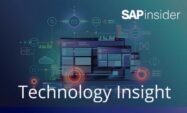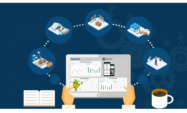SAP Analytics
Filter By
Browse By
- SAP Analytics and AI
- SAP Application Development and Integration
- All SAP Application Development and Integration
- SAP ABAP
- SAP ABAP Development Tools
- SAP ABAP Test Cockpit
- SAP API Management
- SAP BAPI
- SAP Basis
- SAP BRF
- SAP Business Application Studio
- SAP CMS
- SAP Design Studio
- SAP Development Tools
- SAP DevOps
- SAP EAI
- SAP EDI
- SAP Extension Suite
- SAP Fiori
- SAP Fiori Elements
- SAP Integration Suite
- SAP Low Code Application Development
- SAP Low Code Automation
- SAP Netweaver
- SAP Release Management
- SAP UI5
- SAP Web Application Server
- SAP Web IDE
- SAP Business Process Management
- SAP Center of Excellence
- SAP CIO
- SAP Customer Experience
- SAP Data and Data Management
- All SAP Data and Data Management
- SAP BW
- SAP BW/4HANA
- SAP Crystal Reporting
- SAP Data Archiving
- SAP Data Center
- SAP Data Governance
- SAP Data Integration
- SAP Data Migration
- SAP Data Quality
- SAP Data Services
- SAP Data Strategy
- SAP Data Visualization
- SAP Data Warehouse Cloud
- SAP DMS
- SAP Document Control
- SAP EIM
- SAP ETL
- SAP ETL Tools
- SAP HANA
- SAP HANA Administration
- SAP HANA Deployment Infrastructure
- SAP HANA Studio
- SAP Master Data
- SAP Master Data Governance
- SAP MDM
- SAP Enterprise Architect
- SAP Enterprise Asset Management
- SAP ERP
- SAP Finance
- All SAP Finance
- SAP Accounting
- SAP AR AP
- SAP Asset Accounting
- SAP Billing Systems
- SAP BPC
- SAP BRIM
- SAP Cash Management
- SAP Central Finance
- SAP Controlling
- SAP COPA
- SAP Cost Center Accounting
- SAP e-invoicing
- SAP FICO
- SAP Finance Automation
- SAP Financial Closing Cockpit
- SAP Financial Consolidation
- SAP Financial Planning
- SAP FX Risk
- SAP General Ledger
- SAP Global Tax Management
- SAP Hyperion
- SAP Order to Cash
- SAP Payment Processing
- SAP Profitability Analysis
- SAP Rebate Management
- SAP S/4HANA Finance
- SAP Universal Journal
- SAP Governance Risk and Compliance
- SAP Human Capital Management
- SAP Intelligent Technologies
- SAP Platform and Technology
- All SAP Platform and Technology
- SAP Business Technology Platform
- SAP Cloud Connector
- SAP Cloud Integration Platform
- SAP Cloud Migration
- SAP Cloud Platform
- SAP Cloud Providers
- SAP Cloud Strategy
- SAP Container Platform
- SAP Digital Asset Management
- SAP Digital Integration Hub
- SAP Digital Signature
- SAP HANA Enterprise Cloud
- SAP HEC
- SAP Hyperscalers
- SAP Infrastructure
- SAP Messaging
- SAP Smart Forms
- SAP Quality and Testing
- SAP Security
- SAP Spend Management
- SAP Supply Chain Management
- All SAP Supply Chain Management
- SAP APO
- SAP Asset Management
- SAP Business Network
- SAP Digital Manufacturing Cloud
- SAP Digital Twin
- SAP EWM
- SAP IBP
- SAP Inventory Management
- SAP Label Printing
- SAP Logistics
- SAP Manufacturing
- SAP Manufacturing Automation
- SAP MES
- SAP MII
- SAP MM
- SAP MRO
- SAP MRP
- SAP Order Management
- SAP Plant Maintenance
- SAP PLM
- SAP Production Planning
- SAP S&OP
- SAP SD
- SAP SPM
- SAP Supply Chain Planning
- SAP Track and Trace
- SAP Transportation Management
- SAP System Administration
Analytics pertains to leveraging data generated and captured across the organization to generate insights that can help transform the way organizations run. Analytics can also help build capabilities that can automate many aspects of day-to-day decision making that is currently performed manually. There are three main categories of analytics leveraged in organizations today:
Business Intelligence (BI)
Analytics pertains to leveraging data generated and captured across the organization to generate insights that can help transform the way organizations run. Analytics can also help build capabilities that can automate many aspects of day-to-day decision making that is currently performed manually. There are three main categories of analytics leveraged in organizations today:
Business Intelligence (BI)
The end-to-end process of BI involves analyzing the data generated by businesses, transforming the data into insights, and leveraging those insights to make optimal decisions. BI tools primarily leverage “descriptive analytics,” because these tools traditionally focus on analyzing current and historical performance based on data generated by the enterprise.
Machine Learning
Machine learning (ML) is a subset of artificial intelligence (AI) algorithms. The differentiating aspect of these algorithms is that they can learn from the input data and modify the model based on changes in that data. It is this “learning” aspect that makes these algorithms powerful.
Artificial Intelligence
In simple terms, Artificial Intelligence (AI) refers to systems or solutions that can replicate human decision-making capabilities. These solutions often leverage a combination of software and hardware to mimic human capabilities like problem -solving and decision making
Key Considerations
SAP applications leverage AI and ML algorithms extensively to either embed innovative capabilities within their solutions, help end-users perform advanced analytics with minimal technical proficiency, or allow data scientists and ML engineers to build advanced ML models and solutions. SAP HANA has been designed to be easily leveraged as a scalable ML platform. A powerful tool built into SAP HANA is the Predictive Analytics Library (PAL).
SAP Data Intelligence has a rich ML content library. Like most best-of-breed analytics tools, SAP Analytics Cloud provides users the ability to leverage advanced Machine Learning (ML) algorithms. While ML algorithms have many applications, predictive analytics remains a key one.
On the business processes side, SAP AI offerings promise to infuse transformative intelligence to all key business processes areas like lead to cash, design to operate, source to pay and recruit to retire. AI algorithms help include innovative features across all these processes.
81 results
-

DyFlex and Bluetree Join Forces to Deliver Unmatched SAP Capability
Reading time: 1 mins
Bluetree has joined forces with DyFlex Solutions, bringing together two award winning SAP partners to create the largest independent SAP provider in Australia. This union combines our strengths, enhances our collective expertise and unlocks new opportunities for customers across the region. Like Bluetree, DyFlex is highly awarded, locally led and known for delivering enterprise grade outcomes with…
-

- SAP Analytics
 Premium
Premium
Data Democratisation and Intelligent Decision-Making with SAP
Learn how SAP democratises data by making it accessible and comprehensible, ensuring actionable insights, with strategic approaches and architecture designs shared through real-world use cases for business and data leaders. Mastering SAP Premium Access Membership Required You must be a Mastering SAP Premium Access member to access this content.Join NowAlready a member? Log in here
-

Overcoming the Challenges of Predictive Analytics Solutions
Published: 24/July/2023
Reading time: 3 mins
Predictive analytics are a powerful tool. Every company can find some way to benefit from using past data to gain insights into the future. Leveraging predictive analytics to their fullest extent can give organizations an important boost in a competitive market. Nearly every enterprise has access to data, but not all are able to leverage…
-
-

Evolving Business Intelligence in Supply Chains
Published: 05/April/2023
Reading time: 2 mins
As supply chains become more diverse and complex, so do their information systems and associated business analytics systems. The need to build near-real-time visibility, data-driven culture, and digitalization are business imperatives that have forced organizations to invest in data and analytics tools and technologies. However, such tools still need to evolve technologically to address business…
-

- SAP Analytics
 Premium
Premium
Enabling Real Time Insights Into Sustainability In Today’s NFL Stadium
As part of the 49ers sustainability initiative, the Executive Huddle presented by SAP was upgraded this season with new capabilities allowing the team to monitor Levi’s Stadium utility usage, allowing them to monitor consumption of water and gas. To get access to real-time utility data, six 3D-printed water and gas meter readers that feed data…
-

- SAP Analytics
 Premium
Premium
Turbo Charge Your SAP Transformation With a Robust Data Strategy
A robust data strategy is essential to a successful digital transformation with SAP S/4HANA. It should be established at the planning stages of your transformation and needs to consider components such as data management, governance, quality, migration, architecture, analytics, and data retention. Organizations that do not have a data strategy or defer one to later…
-

- SAP Analytics
 Premium
Premium
Beyond the “Standard” Data Replication Scenarios
Many SAP customers struggle to effectively gain analytic capabilities and drive value from the SAP data trapped in their various landscape silos. Daily data loads do not support the agile and forward-looking analytics expected in the modern enterprise. A lack of meaningful metadata makes deciphering SAP data in non-SAP systems a challenge for data engineers. …
-
-

- SAP Analytics
 Premium
Premium
Integrating Analytics and Automation for Supply Chain Resiliency
Published: 09/March/2023
Reading time: 5 mins
Pandemic-related supply chain disruptions have caught the attention of C-suite executives. Leadership now recognizes the importance of supply chain resiliency and are prioritizing and investing in strategies to improve supply chain agility. Resilient supply chains not only mitigate or manage supply chain ris and disruptions efficiently, but they also improve customer service. However, the capabilities…
-

- SAP Analytics
 Premium
Premium
Provide Actionable Insights With Your Next Dashboard
Published: 12/December/2022
Reading time: 6 mins
Dashboards are often created with a boilerplate approach. They sometimes have the most typical metrics listed out, but forget one crucial aspect - what action do we need to take next? The most critical aspect starts with understanding the requirements and making sure that you are visualizing the right KPIs—not just metrics. In this article…
-

- SAP Analytics
 Premium
Premium
Value Based Supply Chain Analytics Through Solution Integration
Published: 21/October/2022
Reading time: 5 mins
In our life, everything is defined by value. And that holds for the world of supply chain management as well. The concept of value stream mapping is to understand which activities within certain processes or a specific process are not adding value to the final deliverable. When we think about analytics or how we need…
Become a Member
Unlimited access to thousands of resources for SAP-specific expertise that can only be found here.
Related Vendors
Your request has been successfully sent

